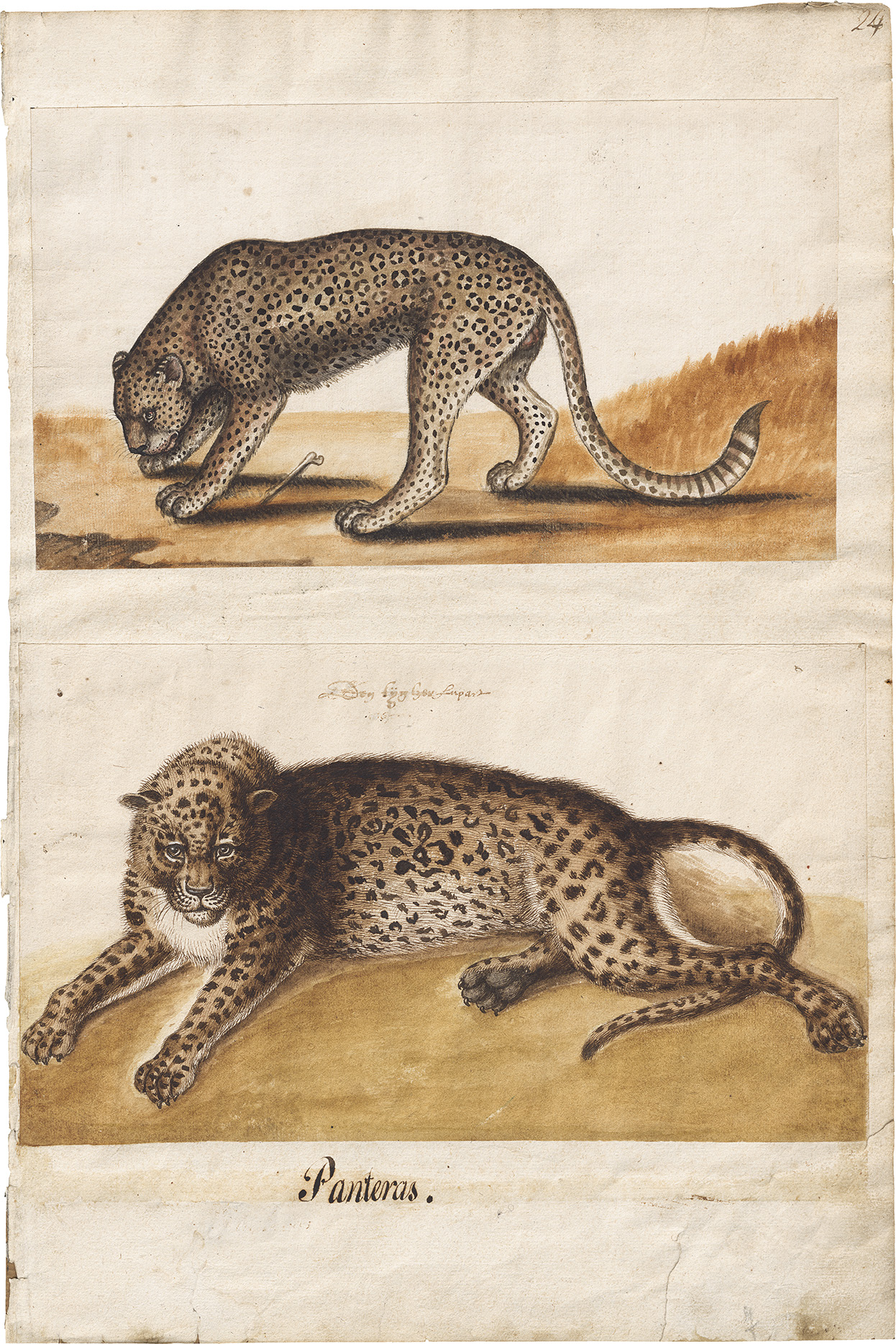Loading the page ...
Flemish School 1567
A Panther, Walking to the Left; A Leopard Lying Down. Pen and brown and grey ink, watercolour and gouache. 16.2 x 28.1 cm and 17.5 x 29.8 cm respectively, mounted on an album sheet 46.7 x 31 cm. “Den tijgher Lupart / (1)567” inscribed in Flemish with the date on the lower sheet, “Panteras” inscribed in a different hand in Spanish. Watermark (album sheet): Crowned double-headed eagle (Briquet 315, Würzburg 1585).
These superb, keenly observed animal studies come from an album of animal drawings commissioned, according to the title page, by Emperor Charles V, who evidently entrusted the Flemish painter, Lambert Lombard, with the compilation of this scientific compendium in 1542. There is reason to doubt
the genuineness of the inscription on the frontispiece, however, since the Habsburg emperor died in 1558 and two of the drawings are dated 1567 and 1570 respectively.
The album probably originally comprised around one hundred animal studies, a large number of which are now in the Rijksmuseum in Amsterdam. Towards the end of the 16th century the drawings were mounted individually on album sheets with the watermark crowned double-headed eagle, which Briquet dates to around 1585. The album must have found its way to Spain at some later date. However, there is no conclusive evidence to show when the concise Spanish captions, which display a limited knowledge of zoology, came to be added (see K. G. Boon, Netherlandish Drawings of the Fifteenth and Sixteenth Centuries, The Hague 1978, vol. II, pp. 223–224).
Whether Lombard, who died in 1570, was the author now also seems far from certain. On the contrary, the album was in all probability a compilation of drawings by several artists, given that the present sheets have different watermarks dating to between 1512 and 1580. Of greater significance, however, is the disparate quality of the individual drawings – a clear indication that several artists were involved in producing the album. Some of the animal images appear a little naive and inept, while others are distinguished by their highly concentrated execution and striking artistic quality.
The depiction of an elk in Amsterdam (inv. no. RP-T-1952-350), for instance, is a very precise and highly finished copy of a drawing made in 1501 by Albrecht Dürer, which is now in the British Museum in London (Winkler 242). Many of the other drawings, meanwhile, reveal remarkably keen powers of observation and have images of great vividness, the only possible explanation for which is that the artist concerned worked directly from nature. The possibility of studying exotic animals in real life certainly existed in the 16th century, since the Habsburg court had several royal menageries in the southern Netherlands, for instance in Brussels and Ghent. Very well known, too, was the menagerie of the Governor of the Habsburg Netherlands, Margaret of Austria (1480–1530) in Leuven, where bison, African civet cats and other wild animals were kept.
The naturalness that is characteristic of many of the drawings in the album is particularly striking in the case of the leopard shown lying down. The artist has used very fine, meticulous strokes of the pen to render the predatory cat’s soft skin and a brush to reproduce the multitude of spots right down to the minutest detail. The white fur on the chest, tail and the inside of the paws stands out very clearly. The elegant beast of prey gazes at the viewer with a skulking, watchful look; it is shown lying down and thus at rest, but its supple body is ready to leap into action at any moment. The immediacy of this feeling for nature suggests that an experienced and talented draughtsman was at work here, yet despite a wide range of different hypotheses it has so far proved impossible to ascribe the quality
sheets in the album to any particular artist. Hence, the present sheet is of considerable documentary relevance not least since the inscription of the year 1567 makes it the earliest dated drawing in the album, whereas it had previously been assumed that this status applied to the depiction of a deer in Amsterdam dated 1570 (inv. no. RP-T-1952-350 A).
Irrespective of the aforementioned doubts as to who made the drawings and when they were produced, the so-called Charles V Album must have been widely known in the late 16th century, since there are stylistic parallels with comparable works by Flemish artists active in the 1570s. For example, there are exact repetitions of motifs from the album inter alia in Joris Hoefnagel’s famous cycle of The Four Elements (National Gallery of Art, Washington D. C.) and in works by Hans Bol (see M. Rikken, “A Spanish Album of Drawings of Animals in a South-Netherlandish Context: a Reattribution to Lambert Lombard”, Bulletin van het Rijksmuseum, vol. 62, no. 2. 2014, p. 113f.). Who copied from whom, however, remains an open question and one that is difficult to resolve. Marrigje Rikken’s recently proposed reattribution to Lambert Lombard seems ultimately to rest on speculation and lacks full conviction. Despite this somewhat confused state of affairs, however, it should be noted, as K. G. Boon has pointed out, that the naturalistic depictions of animals in the album are among the earliest of their kind in northern Europe and continue a pictorial tradition initiated by Albrecht Dürer and Hans Hofmann.
Contact us for further information